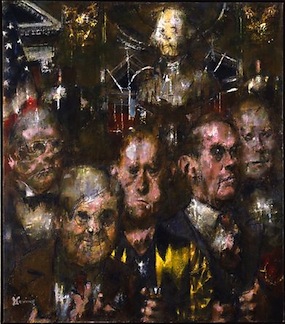Jack Levine facts for kids
Quick facts for kids
Jack Levine
|
|
|---|---|

Finger of Newt 1993-1998
|
|
| Born | January 3, 1915 Boston, Massachusetts, U.S.
|
| Died | November 8, 2010 (aged 95) New York, New York, U.S.
|
| Nationality | American |
| Education | Harvard University |
| Known for | Painting, Printmaking |
| Movement | Social RealismBoston Expressionism |
| Spouse(s) | Ruth Gikow (1946-1982; her death) |
| Awards | Fulbright grant, 1951 |
Jack Levine (born January 3, 1915 – died November 8, 2010) was an American painter and printmaker. He was famous for his artworks that often made fun of modern life. He also painted about political problems and stories from the Bible. Levine is seen as a very important artist in the Boston Expressionist art movement.
Contents
Jack Levine's Early Life and Learning
Jack Levine was the eighth child in his family. His parents were immigrants from Lithuania. He grew up in a part of Boston where he saw many European immigrants and a lot of poverty. These experiences helped shape the art he would later create.
His mother encouraged him to draw. She kept his art supplies in the kitchen. When he visited his father's shoe store, he drew on brown wrapping paper. Even as a child, he drew serious subjects. For example, he drew soldiers patrolling the streets during a police strike in 1919.
Jack's first art lessons were with Harold K. Zimmerman from 1924 to 1931. Later, from 1929 to 1933, Jack and another young artist, Hyman Bloom, studied with Denman Ross at Harvard University. Jack was already very good at drawing, even as a teenager. Ross helped Jack and Hyman by giving them money each week and a place to work.
Jack Levine's Art Career
In 1932, Denman Ross showed Jack's drawings in an art exhibit at Harvard. Three years later, Ross gave twenty of Jack's drawings to the museum. Jack's early art was inspired by other artists like Hyman Bloom and Georges Rouault. He became known for the Boston Expressionism style.
From 1935 to 1940, Jack worked for the Works Progress Administration. This was a government program that helped artists during a difficult time in America. In 1936, Jack had his first art show in New York City. He showed paintings like Card Game and Brain Trust, which showed scenes from everyday life in Boston.
In 1937, his painting The Feast of Pure Reason was shown at the Museum of Modern Art. This painting made fun of Boston politics. That same year, his painting String Quartet was bought by the Metropolitan Museum of Art. After his father died in 1939, Jack painted many pictures of wise Jewish leaders.
Art During and After World War II
Jack Levine served in the United States Army during World War II from 1942 to 1945. After the war, he painted Welcome Home (1946). This painting made fun of how proud and boastful military power could be.
In 1959, this painting caused some disagreement. It was shown in an American art exhibit in Moscow, Russia. Some people in the U.S. government thought the painting showed support for communism. President Dwight D. Eisenhower even said the painting was "more lampoon than art." A "lampoon" is a piece of writing or art that makes fun of someone or something.
In 1951, Jack traveled to Europe with a special grant called a Fulbright grant. He was very impressed by the art of old masters, especially El Greco. El Greco's style inspired Jack to stretch and change the shapes of his figures in paintings to show strong feelings.
After returning to the United States, Jack continued to paint stories from the Bible. He also created Gangster Funeral, which he called a "comedy." He painted more about American life, like Election Night (1954) and Inauguration (1958). In the late 1950s, he also painted beautiful portraits of his wife and daughter.
In the 1960s, Jack's art showed his feelings about social problems in the United States. He painted works like Birmingham '63 (1963). He also painted about international issues, such as The Spanish Prison (1959–1962). Jack once said, "I am primarily concerned with the condition of man." This means he cared most about how people live and the challenges they face. He created art that looked closely at both the good and bad sides of humanity.
In 1979, Jack Levine became a member of the National Academy of Design. After his wife died in 1982, he became more interested in Jewish culture and traditions. This led to many paintings based on stories from the Hebrew Bible.
Exhibitions and Art Collections
Jack Levine's art can be found in many public collections. These include famous museums like the Art Institute of Chicago, the Museum of Modern Art (MoMA), and the Metropolitan Museum of Art. In 1973, the Vatican bought his painting Cain and Abel (1961). Pope Paul VI was pleased with the purchase.
In 1978, a special show of Jack's work was held at the Jewish Museum (New York). In 1989, a film documentary about him was made, called Feast of Pure Reason. In 2005, when he was 90 years old, a smaller show of his art was held in New York City.
Jack Levine's Personal Life and Death
In 1946, Jack Levine married another painter named Ruth Gikow. They moved to New York City and had one daughter, Susanna, who also became an artist.
Jack Levine passed away at his home in New York City on November 8, 2010. He was 95 years old.
See also
 In Spanish: Jack Levine para niños
In Spanish: Jack Levine para niños

